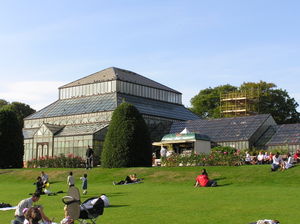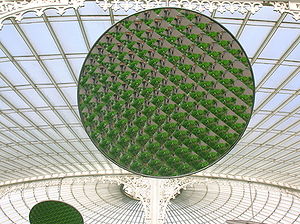
Glasgow Botanic Gardens
Encyclopedia

Arboretum
An arboretum in a narrow sense is a collection of trees only. Related collections include a fruticetum , and a viticetum, a collection of vines. More commonly, today, an arboretum is a botanical garden containing living collections of woody plants intended at least partly for scientific study...
and public park located in the West End of Glasgow
Glasgow
Glasgow is the largest city in Scotland and third most populous in the United Kingdom. The city is situated on the River Clyde in the country's west central lowlands...
, Scotland
Scotland
Scotland is a country that is part of the United Kingdom. Occupying the northern third of the island of Great Britain, it shares a border with England to the south and is bounded by the North Sea to the east, the Atlantic Ocean to the north and west, and the North Channel and Irish Sea to the...
. It features several glasshouse
Glasshouse
Glasshouse or Glasshouses may refer to:*Greenhouse, a building where plants are cultivated*Glasshouse , a 2006 novel by Charles Stross*Glasshouse , term for a military prison in the British Army...
s, the most notable of which is the Kibble Palace. The gardens were created in 1817, and run by the Royal Botanic Institution of Glasgow (founded by Thomas Hopkirk
Thomas Hopkirk
-The Hopkirks:He was descended from a gentry family who came from Hopekirk, near Hawick, by way of Dalkeith in Midlothian,to Dalbeth in Glasgow . His grandfather, also Thomas had been a wealthy Glasgow merchant - a “Tobacco Lord” or “Virginia Don” - who had diversified into coal mining, brewing...
of Dalbeth), and were intended to supply the University of Glasgow
University of Glasgow
The University of Glasgow is the fourth-oldest university in the English-speaking world and one of Scotland's four ancient universities. Located in Glasgow, the university was founded in 1451 and is presently one of seventeen British higher education institutions ranked amongst the top 100 of the...
. William Hooker was regius professor
Regius Professor
Regius Professorships are "royal" professorships at the ancient universities of the United Kingdom and Ireland - namely Oxford, Cambridge, St Andrews, Glasgow, Aberdeen, Edinburgh and Dublin. Each of the chairs was created by a monarch, and each appointment, save those at Dublin, is approved by the...
of botany at Glasgow University, and contributed to the development of the Botanic Gardens before his appointment to the directorship of Kew Gardens
Royal Botanic Gardens, Kew
The Royal Botanic Gardens, Kew, usually referred to as Kew Gardens, is 121 hectares of gardens and botanical glasshouses between Richmond and Kew in southwest London, England. "The Royal Botanic Gardens, Kew" and the brand name "Kew" are also used as umbrella terms for the institution that runs...
in London. The gardens were originally used for concerts and other events, and in 1891 the gardens were incorporated in to the Parks and Gardens of the City of Glasgow.
The site was once served by a railway line, and Botanic Gardens Railway Station
Botanic Gardens railway station
Botanic Gardens railway station was a railway station serving the Botanic Gardens located in the Kelvinside area in the West End of Glasgow.-History:...
remains today in a derelict state as a remarkable example of a disused station. It is hidden behind some trees and a metal fence blocks access to the platforms. Kirklee railway station
Kirklee railway station
Kirklee railway station was a railway station serving the Kelvinside area in the West End of Glasgow.-History:The station was opened on 10 August 1896 by the Glasgow Central Railway...
also lies just inside the gardens.
Kibble Palace

Wrought iron
thumb|The [[Eiffel tower]] is constructed from [[puddle iron]], a form of wrought ironWrought iron is an iron alloy with a very low carbon...
framed glasshouse, covering 2137 m.2 Originally designed by John Kibble for his home at Coulport
Coulport
Coulport is a village on the east side of Loch Long, Argyll and Bute, Scotland.It is 5 miles north-north-west of Cove on the Rosneath peninsula. It marks the end of the B833 shore road, although the village can also be reached by a high-quality but unclassified access road directly from...
on Loch Long
Loch Long
Loch Long is a body of water in Argyll and Bute, Scotland. The sea loch extends from the Firth of Clyde at its southwestern end. It measures approximately 20 miles in length, with a width of between one and two miles...
in the 1860s, the components were cast by Walter Macfarlane at his Saracen Foundry
Saracen Foundry
The Saracen Foundry was the better known name for the Possilpark, Glasgow based foundry company W MacFarlane & Co. Ltd, founded and owned by Walter MacFarlane. Macfarlane's was the most important manufacturer of ornamental ironwork in Scotland....
in Possilpark
Possilpark
Possilpark is a district in the Scottish city of Glasgow, situated north of the River Clyde. Following the closure of the Saracen Foundry in 1967, this section of Glasgow has become one of the poorest in the United Kingdom, with an above average crime rate....
. Eventually brought up the River Clyde
River Clyde
The River Clyde is a major river in Scotland. It is the ninth longest river in the United Kingdom, and the third longest in Scotland. Flowing through the major city of Glasgow, it was an important river for shipbuilding and trade in the British Empire....
by barge to the Botanic Gardens, it was fully erected at its current location in 1873 by Boyd of Paisley
Paisley
Paisley is the largest town in the historic county of Renfrewshire in the west central Lowlands of Scotland and serves as the administrative centre for the Renfrewshire council area...
.
The building structure is of curved wrought iron
Wrought iron
thumb|The [[Eiffel tower]] is constructed from [[puddle iron]], a form of wrought ironWrought iron is an iron alloy with a very low carbon...
and glass supported by cast iron
Cast iron
Cast iron is derived from pig iron, and while it usually refers to gray iron, it also identifies a large group of ferrous alloys which solidify with a eutectic. The color of a fractured surface can be used to identify an alloy. White cast iron is named after its white surface when fractured, due...
beams resting on ornate columns, surmounted on masonry foundations. It was initially used as an exhibition and concert venue, before being used for growing plants from the 1880s. Benjamin Disraeli and William Ewart Gladstone
William Ewart Gladstone
William Ewart Gladstone FRS FSS was a British Liberal statesman. In a career lasting over sixty years, he served as Prime Minister four separate times , more than any other person. Gladstone was also Britain's oldest Prime Minister, 84 years old when he resigned for the last time...
were both installed as rector
Rector
The word rector has a number of different meanings; it is widely used to refer to an academic, religious or political administrator...
s of the University of Glasgow
University of Glasgow
The University of Glasgow is the fourth-oldest university in the English-speaking world and one of Scotland's four ancient universities. Located in Glasgow, the university was founded in 1451 and is presently one of seventeen British higher education institutions ranked amongst the top 100 of the...
in the palace, in 1873 and 1879 respectively - its last use as a public events venue, before becoming wholly used for the cultivation of temperate
Temperate
In geography, temperate or tepid latitudes of the globe lie between the tropics and the polar circles. The changes in these regions between summer and winter are generally relatively moderate, rather than extreme hot or cold...
plants. The main plant group is the collection of Australia
Australia
Australia , officially the Commonwealth of Australia, is a country in the Southern Hemisphere comprising the mainland of the Australian continent, the island of Tasmania, and numerous smaller islands in the Indian and Pacific Oceans. It is the world's sixth-largest country by total area...
n tree ferns, some of which have lived here for 120 years.
In the 1920s a statue was added in the palace to "King Robert of Sicily" a figure from the works of Longfellow. This is by the Scottish sculptor George Henry Paulin
George Henry Paulin
George Henry Paulin, often called Harry Paulin, or 'GHP' was a Scottish sculptor and artist of great note in the early 20th century....
.
In 2004 a £7 million restoration programme was initiated to repair corrosion of the ironwork. The restoration involved the complete dismantling of the Palace, and the removal of the parts to Shafton
Shafton
Shafton is a civil parish in the Metropolitan Borough of Barnsley in South Yorkshire, England, on the border with West Yorkshire. At the 2001 census it had a population of 2,840. The parish contains the villages of Shafton and Shafton Two Gates....
, South Yorkshire
South Yorkshire
South Yorkshire is a metropolitan county in the Yorkshire and the Humber region of England. It has a population of 1.29 million. It consists of four metropolitan boroughs: Barnsley, Doncaster, Rotherham, and City of Sheffield...
for specialised repair and conservation. The plant collection was removed completely for the first time ever and the ironwork was rebuilt over a rearranged floorplan, giving the Palace a prolonged life. It re-opened to the public in November 2006.
External links
- Botanic Gardens: Information from Glasgow City Council
- Kibble Palace: Information from Glasgow City Council
- Photographs of the Kibble's Restoration

